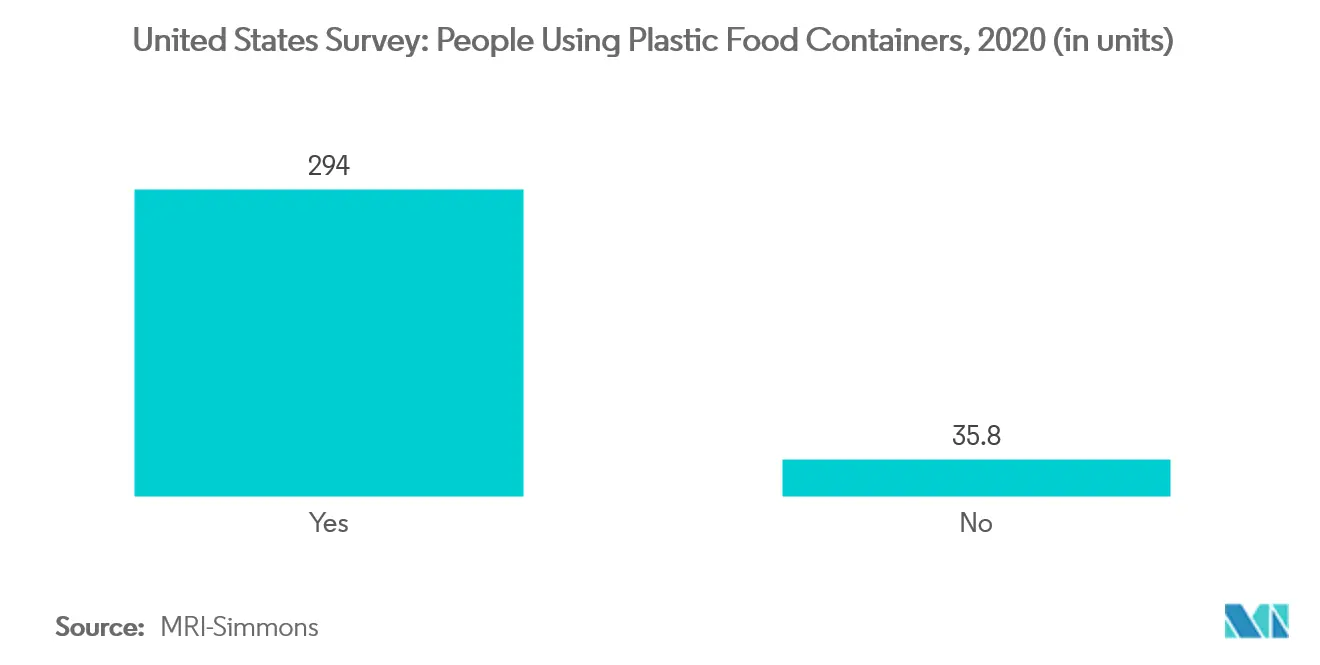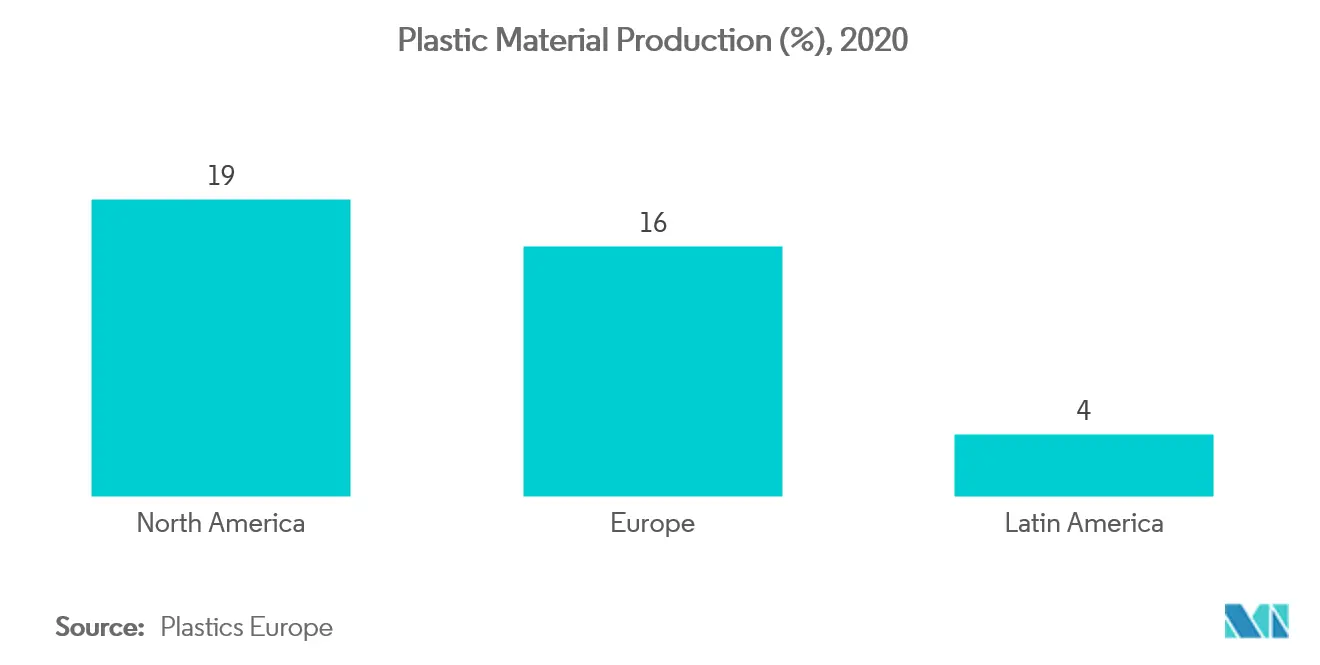Market Trends of NA Plastic Packaging Industry
This section covers the major market trends shaping the North America Plastic Packaging Market according to our research experts:
Food from end-user – flexible plastic packaging is expected to hold lagest share during the forecast period
- The food segment holds a prominent share of the market studied due to the rising demand for food services and the growing retail food business. The consumers in the region are increasingly becoming cautious about maintaining a healthy diet, which is transforming the time of fresh, healthy food being delivered to them, which, in turn, is expected to augment the demand for flexible food packaging.
- The FDA highly regulates the food industry in the country. The FDA regulates most packaged foods sold in the country and has specific requirements, such as what elements a package must contain, identity statement, net quantity, nutrition facts, and ingredients. The government body has a particular set of packaging rules based on food contact substances, irradiation of food and packaging, and environmental decisions.
- The FDA is developing an updated database of packaging factors (PFs) for food contact substance notifications (FCNs) that may include PFs for 550 food items. The development is in line with the push from various NGOs in the country to pull the FDA's approval of PFASs in food packaging.
- The demand for flexible packaging is rising due to the increase in exports of packaged foods. Processed food products from Canada are exported to 190 countries. A significant share of the products is exported to the United States, China, Japan, Mexico, Russia, and South Korea. According to StatCan, the export value of processed food products from Canada was CAD 28 billion.
- The country is also witnessing an increasing growth in its retail and food services sales. The demand for on-the-go consumption, and fast food, among others, is driving the growth of processed food, which, in turn, is boosting the flexible packaging market. According to the USDA Foreign, Agricultural Service studies 2019, the expected sales growth of packaged food in Canada between 2017 and 2022 may be driven by sweet biscuits, snack bars, and fruit snacks with 19.8% growth followed by spreads, edible oil, dairy with 15.8%, 13.8%, and 12.3% respectively. Additionally, according to the same study, the import of packaged food in 2018 was CAD 24.8 billion.
- In the recent past, US Food and Drug Administration (FDA) signed an arrangement with the Canadian Food Inspection Agency (CFIA) and the Department of Health Canada (Health Canada). The agreement is aimed at recognizing food safety systems and inspections. Thus, with the need to comply with packaging product quality standards of the FDA, Canadian manufacturers have sought to adopt enhanced packaging materials and systems for their products.
- Moreover, leading manufacturers of aluminium foil containers in the United States and Canada have formed an association, the Aluminium Foil Container Manufacturers Association (AFCMA), dedicated to producing top quality products and educating the public of the advantages of aluminium foil containers.

Canada is expected to hold the largest market
- Many consumers in Canada are increasingly moving toward eco-friendly packaging materials. As the usage of plastic and plastic products has potentially hazardous implications on the environment, governments in these countries have imposed very stringent rules and regulations in the industry, making it a relatively slower-growing industry compared to other materials.
- At the same time, Stewardship Ontario's "Plastic Is In" campaigns in municipalities are stimulating the supply of rigid plastic containers in curbside Blue Boxes. Ontario bottled water manufacturer Ice River Springs' Recycling Division uses a mix of PET bottles and supermarket shells to create 100% recycled bottles. It is one of the first working groups focused on packaging reduction and waste diversion, bringing together representatives from the packaging and waste management industries, government, universities, industry associations, and Walmart vendor partners.
- The Walmart Canada Packaging SVN launched the Sustainable Packaging Scorecard, which evaluates the sustainability of product packaging based on several criteria, such as material type and weight, product-to-package ratio, and cube utilization. They also collaborated with representatives of several other organizations to form the Material Optimization Committee, aimed at exploring how to improve recycling rates for packaging and increase the volume of waste diverted from landfills.
- With the increased focus on sustainability, companies are focusing on adopting eco-friendly and recyclable products. Each year, the Canadian plastics industry undertakes proactive outreach and program support to municipalities across Canada in order to increase the amount and types of plastics collected for recycling. Recycle BC is a not-for-profit organization responsible for residential packaging and paper product recycling throughout British Columbia.
- Komori and Komcan Inc. extended their presence in the Canadian packaging market by providing flexible packaging companies with machinery and equipment. For instance, Produlith Packaging replaced two competitive presses with the purchase of a six-color Komori Lithrone GX40 with coater (GLX640C) and H-UV ink curing system along with Komori's KP-Connect, a cloud-based technology for data-driven operations that offers real-time control of all printing processes.
- According to the recycling council of Ontario, Canada recycles about 9% of its plastics, with the rest dumped in landfills or tossed away as litter. Consumers in the country are increasingly moving toward recyclable food packaging materials and prefer brands that are responsible for their packaging that pushes the market for flexible packaging.
- In February 2020, major Canadian food and beverage packaging companies collaborated to develop a circular economy for plastic in the country. The companies are also innovating and developing flexible food packaging products in the region. For instance, in July 2019, ProAmpac achieved silver PAC Canadian leadership awards for designing the packaging for new children's snacks and the second for graphics innovation in flexible packaging for premier hair care products.

